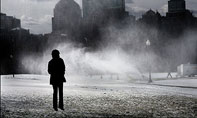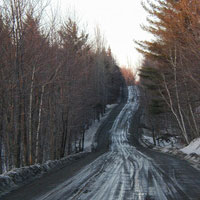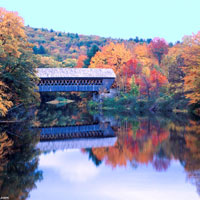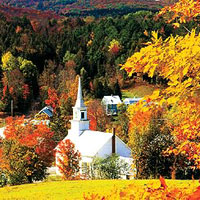- About Us
- Columns
- Letters
- Cartoons
- The Udder Limits
- Archives
- Ezy Reading Archive
- 2024 Cud Archives
- 2023 Cud Archives
- 2022 Cud Archives
- 2021 Cud Archives
- 2020 Cud Archives
- 2015-2019
- 2010-2014
- 2004-2009
 |
A Postcard from New England |

Like an ancient serpent the two lanes of tarmac slither into the distance. The black asphalt, shimmering with the last vestiges of morning dew, is eventually lost at the blurred line between the azure ocean and the endless blue sky of early summer. A fierce machine, wearing the dazzling livery of the paddock thunders into view. Slipping along the roadway, amidst the mechanical braying of its one hundred horses, this high-tech mount gallops along the darkened pavement in a modern joust with the dragon called highway.
At least that's how I was hoping to spend my day. I love to ride, but in reality, I live in New England, and it’s late February. My noble steed is lopsided on her kickstand, in the corner of a cold dark garage, glaring at me through polished feline headlights. Luckily, I can avoid that predatory glare by hiding behind the frosted window of my garage and the curling plumes of steam rising from my coffee. You can add to this absence of life that the poor beast really has no chance of starting in the -8° Celsius temperature anyway, much less actually traversing my yard that's covered in nearly half a meter of snow. It’s just all too much for my poor little bike, and I think the last bit of electricity has ebbed from her once strong battery.
Welcome to a strange little corner of the United States that the locals call New England. Some of you may have heard of it. Less of you may have actually come here, lured by the images of fall foliage, covered bridges, and quaint little sea towns. In reality New England is the Hell of motorcyclists. Most riders get between four and five days of good riding a year. (Those who ride BMW bikes get considerably more time to ride, but we all know that they are a little different anyway. I actually saw one riding in the snow with skis strapped to his bike.) One fact that is kept out of the New England guidebooks is a neat little hill we call Mt. Washington. Its claim to fame is that it's the home of “The worst weather on Earth!” Wind speeds have been clocked at over 370 km/h and temperatures recorded that were lower than -57°c without the wind-chill. Does it sound like fun yet?
Like other places we have four season s, they just don't go by regular names. Winter here is known as ‘Snow or Ice season’. I capitalized those words out of respect to whatever god or spirit that controls them. Okay, it’s not really respect- it’s fear. You really haven't lived until you've experienced only getting eight hours of daylight every twenty-four hours, and you’ve had the chance to shovel out from a storm that dumped over a meter of snow in one night. Being a truly warped breed, New Englanders like to brag about being around for the big blizzards, or Nor’easters as we call them. People tend to look at you funny when you can't account for what you were doing back in '78, the April Fool's storm, or the no-name storm of ’04.
s, they just don't go by regular names. Winter here is known as ‘Snow or Ice season’. I capitalized those words out of respect to whatever god or spirit that controls them. Okay, it’s not really respect- it’s fear. You really haven't lived until you've experienced only getting eight hours of daylight every twenty-four hours, and you’ve had the chance to shovel out from a storm that dumped over a meter of snow in one night. Being a truly warped breed, New Englanders like to brag about being around for the big blizzards, or Nor’easters as we call them. People tend to look at you funny when you can't account for what you were doing back in '78, the April Fool's storm, or the no-name storm of ’04.
Spring, depending on what part of New England you are from, can be known as either ‘mud season’ or ‘pothole season’. Mud season occurs in the more northerly areas, and is so named because when the ground thaws and the snow melts there is nothing but mud left behind. Usually it lurks around for weeks, as well. The potholes could more accurately be called ‘tank traps’. It’s not uncommon for the ground to give way into holes that can easily swallow a small fleet of cars. This doesn't just happen on back roads, but also adds to the excitement of a morning commute when a giant hole suddenly appears in the middle of a major highway.
Summer here is often known as ‘black fly season’. That’s really a mystery as it contains, in order of size if not voracity, ‘No-see-ums’, black flies, deer flies, horse flies, and moose flies. It’s during this particular time of year that a person's vision will be regularly obscured by clouds of ill-tempered biting insects. Tourists who visit during this season often don't believe in the existence of covered bridges as their soft skin is considered a delicacy by our biting insects. Consequently they are either afraid to go outside, or just can’t see through the haze of bugs. It is because of this that New Englanders can actually differentiate a particular insect by how painful the bite is. My particular favorites are the little monsters called No-see-ums. They are not only talented in their ability to pass through the screens of camping gear, but they can also devour portions of human flesh in under a minute. Add to this that during the day humidity hovers around 90% and temperatures float around 32C, and you have a delightful atmosphere indeed.
Autumn has the shortest and most familiar name. We call it Fall. You may too, but here in New England it’s called that because we tend to fall to our knees and pray to God that Snow and Ice season will be mild. In all actuality fall is also the only chance we have for a perfect day. Warm days and cool nights are offset in nearly twelve-hour intervals. The bugs are gone. If you know where to go, the trees present one with an extraordinary collage of colors. In these serene months are some of the few days of respite in a given year that a lucky person can find peace between black fly season and snow season that make living in New England worth living for the rest of the year.
 Well it seems that my camouflage is giving way. The wisps of steam have subsided, partly because my coffee has frozen solid. Looking around there are buds on the trees, and mud-season can’t be far from poking through. If I’m not mistaken I can see a little glimmer in the headlights of my old ‘Hawk, and that ominous buzzing sound is a sure sign that the bugs are warming up. I guess that’s my cue to retreat indoors.
Well it seems that my camouflage is giving way. The wisps of steam have subsided, partly because my coffee has frozen solid. Looking around there are buds on the trees, and mud-season can’t be far from poking through. If I’m not mistaken I can see a little glimmer in the headlights of my old ‘Hawk, and that ominous buzzing sound is a sure sign that the bugs are warming up. I guess that’s my cue to retreat indoors.
